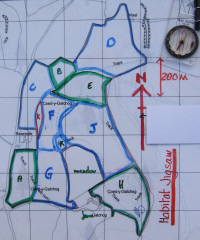As a new owner how on earth do I decide what to do?
The problem is that advice is usually written in silvicultural or conservation management speak. Frequently this is too technical for the owner to comprehend adequately and they struggle to relate this to what they perceive of their woodland. Rather, the owner must be enabled to empathize with their woodland and thus empowered, develop a vision that harmonises owner and woodland. As a result they are in control,firmly on the learning curve and a woodland culture of the 21st century emerges.
The owner takes over
Every woodland is unique. The Habitat jigsaw (opposite) reflects this, providing opportunity to acquire skills through learning by observation. It assists the owner to comprehend the diversity of their woodland and identify the pieces – dry, damp, wet areas, soils, rock, climate, etc. The owner must be involved in this mapping process, walking every inch of the ground, becoming familiar with the features and variations. It is vital to have the helping-hand of someone who can walk with them and explain the woodland as a living vibrant entity.
* A large base map is essential. The 1870’s OS at 25” to the mile, obtainable from many County Record Offices is amazingly detailed and accurate. It shows features such as boundaries, rides and streams, to which we can relate. Draw on this a north/s east/w grid to scale, and enlarge to a convenient size (A3 or more), For outdoors on a dry day laminate and use special whiteboard felt pens, transfer the information indoors and wipe the laminate clean. Otherwise photocopy. Use a mapping compass (allowing for magnetic variation) to locate features.
*Walk the woodland again and again, off the paths observing every feature, familiarising yourself with every variation and corner. It takes at least a full year to complete, over all four seasons, to become familiar with your woodland. Every part will be different– ferns, damp/wet hollows, flowers, aspect, rock outcrops, access, etc.
What emerges is a detail understanding of the woodland.
Like a moth eaten blanket, it is a fragment of the original wildwood in miniature. From this will become apparent where a helping-hand might be beneficial, where to make glades, ponds/ pools, retain old trees, etc, make rides and paths, and even perhaps, to leave well alone!




